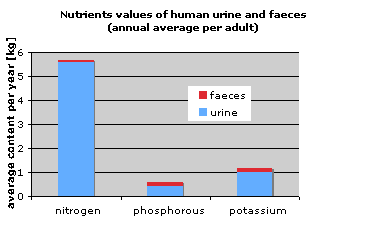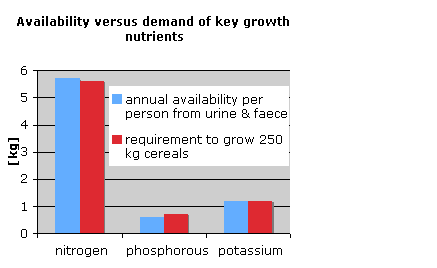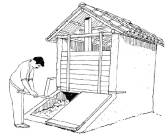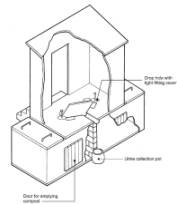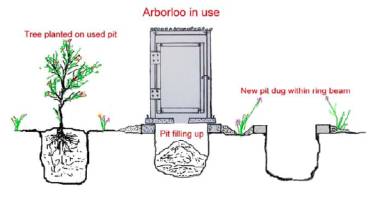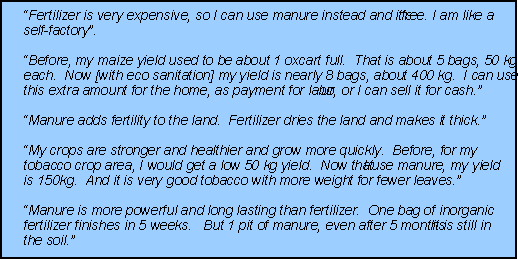|
|
WELL FACTSHEETEcological Sanitation Authors: Jo Smet and Steven Sugden, April 2006 Quality Assurance: Sandy Cairncross Ecological sanitation - What is it? Eco Sanitation works on the principle that urine and faeces are not simply waste products of the human digestion process, but rather are an asset that if properly managed can contribute to better health and food production and reduce pollution. Eco-sanitation latrines:
Since
early Chinese history, human excreta was commonly
used in agriculture to complement farm manure in
improving soil fertility. Farmers owned
‘Outhouses’ where they invited visitors to leave
behind their ‘valuable’ excreta. In
early Europe, Greek and Roman societies collected
human excreta and used it as fertilizer. The Romans
found that urine contained high value
nutrients and collecting it was a good business.
Emperor Vespasian introduced a ‘urine tax’ along
with the proverb pecunia
non olet (Money does
not smell). In Britain, Queen Victoria used an earth-closet at
Windsor Castle, although many types of water-closet
were available. Henry Moule in 1840’s was the
champion of the earth-closet and backed up his
belief with a scientific experiment where he
persuaded a farmer to fertilise one half of a field
with earth from his closet, and the other with an
equal weight of superphosphate. Swedes were planted
in both halves, and those nurtured with earth manure
grew one third bigger than those given only
superphosphate. For
many years, the earth- and water-closets were rival
systems with champions and detractors on both sides. The nutrition value of urine and faeces as fertilizers
(500 litres of urine and 50 litres of faeces are about the amounts produced by one adult in a year) Note that most of the nutrients are in the urine, though the vast majority of the pathogens are in the faeces. Although faeces has a lower nutrient content, its high organic matter aids water retention and is a good soil improver.
Fig1: Nutrients for plant growth present in human faeces and urine Ecological latrines can be divided into two main types: (i) dehydrating urine separating toilers and (ii) composting toilets. (i) Dehydrating urine separating toilets The urine and faeces are collected and stored separately by the use of specially designed pedestals and slabs.
Fig.2 Dehydrating latrine with urine diversion and the principle of a urine diversion latrine The urine is collected and stored until it can be used
as a fertilizer on plants or crops. The faeces drops
into a pit, vault or container to which a handful of either ash or
lime is added. This has the effect
of drying the faeces and increasing the pH which has
a positive impact on reducing smell (less ammonia
emission) and destroying
pathogens (see GTZ-EcoSan Datasheet-2).
After 12 months of storage the resulting
‘humanure’ can be applied to the land. Some form
of alternating double or multiple storage system is
required to avoid mixing fresh and composted manure. (ii)
Composting
toilet The double-pit or vault composting latrines do not
separate the faeces and urine, so that both
enter the same vault or pit. A handful of a mixture
of soil and ash is added to the pit after each use
which has the effect of keeping the pit contents
relatively dry and aerobic, as opposed to anaerobic and
smelly. ‘Composting’ is not technically the
correct name as the temperatures never rise high
enough to create themophilic composting conditions.
After 12 months of storage the resulting
‘humanure’ can be applied to thet land as a
fertilizer and soil conditioner. The simplest form
of composting latrine is called the Arborloo or
‘walking latrine’ (see below).
Fig3: Arborloo as introduced in Southern Africa
Reasons to adopt ecological sanitation In
many Developing Countries poor soil fertility and
the increasing cost of artificial fertilizer is
making it difficult for subsistence farmers to grow
enough food to feed their families. Survival becomes
more perilous as population growth means new land to
cultivate is not available. The fertilizer producing
qualities of ecological latrines can help the
household economy of poor families as demonstrated
by the following comments collected from Malawian
farmers who have been using eco-sanitation for a
number of years,
In their testimony, these farmers allude not only to the nutrient quality of the ‘humanure’, but also how the organic matter from the faeces improves soil structure. The
act of adding ash and/or soil and separating the
urine has the effect of drying the faeces and the
possibility of pathogen transmission to the water
table is eliminated. This makes eco sanitation a
particularly good option in areas where
contamination of groundwater is a sensitive issue. In
water stressed or arid areas, ecological
sanitation (which needs no water for flushing) can help save this valuable resource.
In the developed countries of
the north it has been estimated that use of
ecological sanitation could reduce domestic water
consumption by 20-40%. Conventional
sewage systems effectively remove faecal material and the
pathogens it contains from the immediate household
and community environment and deliver it to a sewage
treatment works. In many countries the sewage works
are incapable of effectively treating the waste as
the volume entering the plant exceeds its design
capacity (either because of population growth, the
high cost of electricity or the
mixing of sewage with storm water). The result is
that poorly treated sewage is discharged into
streams and rivers with detrimental effects on the
rivers' flora and fauna. It is argued that if
eco-sanitation was more widely used, the need to
build and operate expensive sewage works would
diminish and the water quality in the rivers would
improve. In
developing countries, areas with high groundwater
tables and collapsing sandy soils are notoriously
difficult in which to build permanent traditional
latrines. Ecological
latrines with their shallow pits or vaults can
provide good, sustainable affordable solutions. Faeces
in all cultures is regarded as disgusting
and to
many people, the thought of using it for
food production is
repulsive. In addition, many cultures have
strongly-held beliefs and taboos regarding faeces that make
ecological sanitation unworkable. This
avoidance
instinct has self preservation at its heart
as
faeces contains many pathogens that are
harmful to
man if ingested. Even where there is no risk
of
disease transmission, the cultural
perception may be
different as demonstrated by this Malawian
farmer:
“If I eat crops and fruit grown in my own excreta, it can provide
disease”.
People
generally prefer toilets where faeces cannot be seen
and where no further handling by the users is
required. With a water closet the only necessary
further user action is the pulling of a handle; out
of sight out of mind. With eco-sanitation there is
always some form of secondary handling of the faeces
and user reluctance to do this could be high. Even
if an individual is willing to adopt eco-sanitation,
they may be put off from doing so by the fear of
being ridiculed by the rest of the community.
Sanitation systems are one of the key defences in breaking the faecal-oral transmission routes of many diseases. The capacity of a latrine to either ensure no further human contact with faeces or to reduce the pathogens to safe levels is an essential prerequisite. With ecological latrines, their ability to perform the latter is questionable. The potential health risks associated with ecological sanitation Ecological latrines use the following techniques to ensure pathogens die off:
Ascaris is the most persistent pathogen in
faeces and is therefore used as an indicator of
pathogen removal efficiency. In a well managed ecological latrine where one or a
combination of the above environmental conditions
has been acgieved in
the pit or vault, Ascaris eggs will be reduced to a level where they do not present
a risk to public health. Problems arise when the
latrine is not well managed and the user has either
misunderstood or does not followo the management
regime stipulated by the designers. Unfortunately
this is common and is one of
the major weaknesses of ecological sanitation. However, pathogen destruction in ecological
sanitation is often viewed from the negative angle
of what it does not achieve with regard to Ascaris
die-off, and never from the angle of what it does
achieve with a whole host of other pathogens. Ecological latrines, where
storage times are greater than 3 months, will reduce
to safe levels the pathogens responsible for Ameobiasis, ,
Giardiasis, Hepatitis A, hookworm, Trichuris
(whipwork), Enteribius
vermicularis (threadworm), Hymenolepis
nana, Rotavirus, Cholera, Campylobacter,
Eschericia coli, Salmonellosis, Shigellosis and
Typhoid. The debate about the safety of ecological sanitation often occurs in isolation of the context in which it is being practiced and the larger question of whether the introduction and practice of ecological sanitation will improve the overall health of a community is never addressed. Generally speaking, from a health perspective an ecological latrine is better than no latrine at all and any possible health risks must be weighed against the potential improvement in the household economy and a family's ability to feed themselves. Ongoing
research and learning on EcoSan
Research,
demonstration and full-scale programmes are
financed by many Southern and Northern
governments and organizations. Some major
donor-supported programmes are GTZ EcoSan (www.gtz.de/ecosan),
Sida-supported EcoSanRes (www.ecosanres.org).
The websites give also reference to
other ongoing research. Three international
EcoSan Conferences/Symposia have been
organised (China, Germany and South Africa).
Home > Resources > Fact sheets > Public Private Partnerships and the poor |
|||||||||||||||||||||||||||||||||

